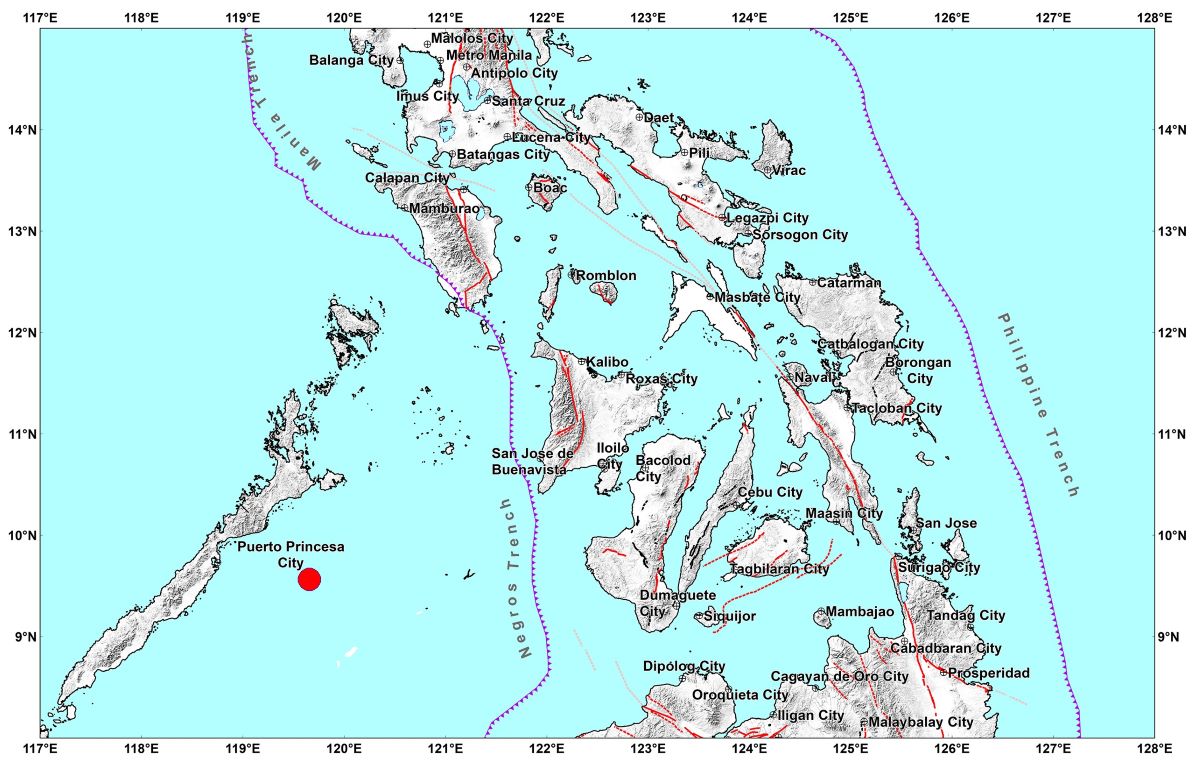'Stable' Palawan vulnerable to seismic events, say PHIVOLCS scientists

State seismologists see the need for robust disaster preparedness measures as the province of Palawan, which is known to be a seismically stable area, was shaken by two earthquakes in June.
Palawan was hit by a magnitude 5.1 earthquake on June 11, followed by a magnitude 4.2 earthquake on June 13.
“The occurrence of these earthquakes underscores the importance of robust disaster preparedness measures, particularly in anticipating other potential hazards like tsunamis. Relying on isolated events for seismic hazard assessment is inadequate; a comprehensive geological investigation is essential to accurately identify seismic sources,” according to a study published by experts from the Philippine Institute of Volcanology and Seismology (PHIVOLCS) on July 3.
“Such an investigation would need to thoroughly reevaluate Palawan’s seismic potential to ensure appropriate seismic safety measures are implemented, especially for critical installations such as proposed nuclear power plants and associated nuclear waste facilities,” the study added.
The strongest earthquake recorded in Palawan to date was magnitude 5.9 on December 19, 1940.
Palawan saw earthquakes between 2013 and 2015, mostly offshore, with magnitudes ranging from 3.9 to 4.7. Most of these earthquakes were not noticed by locals.
According to the study, Palawan sits atop the Eurasian plate, unlike the rest of the Philippines, which is located within the Philippine Mobile Belt, an area marked by active tectonic movements, studded with volcanoes, and replete with earthquake activity.
But the experts discovered there are active faults nearby, and Palawan can experience shaking from strong earthquakes that hit other parts of the Philippines.
“Though located relatively far from the active plate boundaries in and around the Philippines, Palawan experiences earthquakes because elastic strain energy can still build up in Earth’s crust far from active plate boundaries,” the experts said.
“In other words, tectonic stress from surrounding active regions can extend into Palawan, causing strain to accumulate. This strain eventually needs to be released through movement along faults.”
But the strain accumulation and release occur at a much slower rate because Palawan is in a ''relatively stable tectonic region,'' the experts said.
Where are these faults?
The study said reverse faults had been identified in the northwest Sulu Sea following the June 11 earthquake.
''Our preliminary analyses focused on the region’s active tectonics using high-resolution bathymetric data available from the National Mapping and Resource Information Authority (NAMRIA) of the Philippine government. This analysis reveals potential earthquake-generating faults that had previously been overlooked due to the availability of only low-resolution data in past years,'' the experts said.
They said ''the current map of PHIVOLCS does not indicate any active faults in the area, which made initial identification of the source fault difficult.''
“The relative activity of these offshore structures has not been fully assessed. Yet, based on geomorphic features, the seafloor deformation observed, and the occurrence of the June 2024 earthquake, it is plausible that these offshore faults are active and could be potential sources of future earthquakes.''
Meanwhile, the June 13 earthquake “appears more typical due to its proximity to an active tectonic boundary, the Manila Trench,'' they said.
The experts said that earthquake records and the presence of potential active faults indicate that Palawan is ''vulnerable to seismic events.''
''Another major concern is the potential for tsunamis, given Palawan’s extensive coastlines and proximity to offshore tectonic structures. Historical records indicate that both northern and southern Palawan were affected by a tsunami during the 1897 magnitude 7.5 Sulu Sea earthquake,'' the study said.
“This highlights the necessity for continuous monitoring and detailed geological investigations to effectively understand and mitigate the risks in a relatively stable region. Although the earthquakes in Palawan may not be surprising, these events highlight the importance of enhancing our understanding and preparedness to better protect the residents and infrastructure of Palawan from the impacts of future earthquakes.'' —VBL, GMA Integrated News




